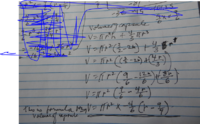There are certainly problems for which only an approximate answer is possible, and such problems are studied in numerical methods. But those methods require a specification of when an approximation is good enough. In this case, you can at least try for an exact answer.but, if I use the ratio .5/0.3333=x/1.5 I get 2.25 and this IS a good approximation of the right answer. .................edited
There are only six possible rational roots to try according to the rational root theorem, and the negative ones do not look promising.
[MATH]8 \left ( \dfrac{1}{8} \right )^3 - 18 \left ( \dfrac{1}{8} \right )^2 + 1 = \dfrac{1}{64} - \dfrac{18}{64} + \dfrac{64}{64} \ne 0.[/MATH]
[MATH]8 \left ( \dfrac{1}{4} \right )^3 - 18 \left ( \dfrac{1}{4} \right )^2 + 1 = \dfrac{1}{8} - \dfrac{18}{16} + \dfrac{8}{8} = \dfrac{1 + 8 - 9}{8} = 0.[/MATH]
[MATH]\therefore r = \dfrac{1}{4} \text { is one solution.}[/MATH]
[MATH]\dfrac{8r^3 - 18r^2 + 1}{r - \dfrac{1}{4}} = \dfrac{32r^3 - 72r^2 + 4}{4r - 1} = \dfrac{32r^3 - 8r^2 + 8r^2 - 72r^2 + 4}{4r - 1} =[/MATH]
[MATH]8r^2 - \dfrac{64r^2 - 4}{4r - 1} = 8r^2 - \dfrac{64r^2 - 16r + 16r - 4}{4r - 1} = 8r^2 - 16r - \dfrac{16r - 4}{4r - 1} = 8r^2 - 16r - 4.[/MATH]
[MATH]\left (r - \dfrac{1}{4} \right ) (8r^2 - 16r - 4) = 8r^3 - 16r^2 - 4r - 2r^2 + 4r + 1 = 8r^3 - 18r^2 + 1.[/MATH]
[MATH]16^2 - 4(8)(-\ 4) = 16(16 - 8) = 8 * 2 * 8(2 - 1) = 8^2 * 2 * 1 = 8^2 * 2.[/MATH]
[MATH]r = \dfrac{16 \pm \sqrt{8^2 * 2} }{2 * 8} = \dfrac{16 \pm 8\sqrt{2}}{16} = 1 \pm 0.5 \sqrt{2}.[/MATH]
At this point, you have three EXACT answers. The two involving the square root of 2 can be given a decimal approximation to any required degree of accuracy.
You do not need anything but algebra and arithmetic.
Last edited:


